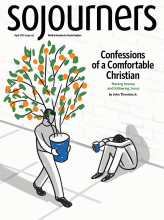IT BEGAN ON CHRISTMAS EVE, six months after I became the senior pastor at First United Methodist Church. I had been welcomed by most people in my California Central Valley town, even though I was the first woman preacher most of them had ever met.
I entered the sanctuary robed in black, with a colorful stole around my neck (the symbol of the towel Jesus lay over his shoulders when he washed his disciples’ feet). I felt confident, even on a night when many community members would be in church for the first time or had come for their once-a-year worship experience.
I lit a dozen candles on each of two standing candelabras, and red poinsettias glimmered all around me as we sang “Joy to the World.” I preached a sermon from the first chapter in John’s gospel that says light shines in the darkness and darkness has not overcome it. I served communion to parishioners, friends, and slightly eggnog-tipsy extended families. At midnight, we dimmed the lights and sang “Silent Night” by heart, with only the glow of hand-held candles filling the room. I blessed the congregation with raised hands, honored by the privilege in this call to the ministry I embodied, and walked to the entryway to greet everyone.
Most people came by and shook my hand but didn’t linger—they had gifts to open or chores to finish for the next day. At the end of the line came a smiling, grey-haired man who was the lay leader of the church. He was in his 70s, fair-skinned, and nearly six feet tall. He took my hand and kept it beyond my comfort level. Then, as I pulled away, he gripped tighter, cupped his other hand on the top of mine, leaned closer to me, and whispered, “You look beautiful in candlelight.”
Read the Full Article

